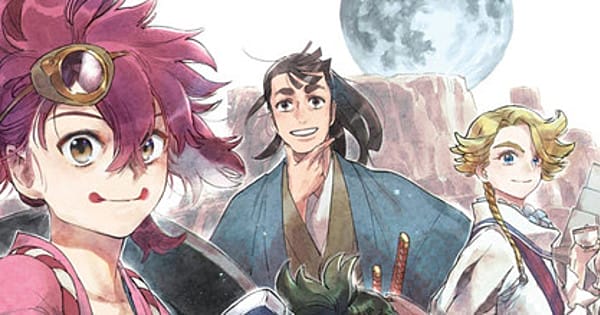
Appare-Ranman! GN
It’s quite terrible that Appare-Ranman! has never gained a large English-speaking following since its debut in 2020. It had a lot to offer a wide audience with its dynamic storyline, engaging ensemble cast, and interesting wild west setting, but it never really caught on. The manga version, created alongside the anime series, ran in the seinen-oriented Young Ace magazine until 2022, and has now been released in the United States by Yen Press in one massive, 650-page book. Maybe this release will help Appare and Kosame finally find the adoration they deserve among Anglophones.
If nothing else, Ahndongshik (incorrectly romanized as Antonsiku here) will undoubtedly attract some attention. The illustrator, who created the anime’s eyecatchers and designed the characters, has a keen eye for dynamic character expressions, motion, and panel layout. He has a good grasp of anatomy that pops through at every turn, as he avoids standard anime-style proportions, resulting in characters that are lifelike but nonetheless stylized. Kosame’s blockiness and blunt edges emphasize his square personality, while his kimono and topknot communicate his traditionalism, in contrast to Appare’s wild, colorful mishmash of western and eastern styles, kabuki makeup, and voluminous pigtails communicate his unconventionality. I can’t help but notice how well he paints ladies – Xialian, the only female racer, is stunning by any standard, but her physique has structure and weight to it as well as an impossible hourglass figure.
There are various flaws with the character designs as well, most of which are related to the ethnically varied group. Hototo, an indigenous child, dresses in buckskin and feathers and fights with a tomahawk, all stereotyped signifiers thrown together with no concern for any particular tribe or culture, and his precise background is not specified. TJ is a Black man who gets strung up with a noose around his neck. Their backstories are a little muddled, as the tale focuses on the marginalization that many of the racers experience. Hototo’s father’s murder is linked to the genocide against Native Americans, and he is expressly discriminated against by white settlers. Appare and Kosame endure similar discrimination as “orientals,” and while Xialian’s race isn’t mentioned as a factor in her own marginalization, she learns to drive at night because she’s barred from racing at the track where she works owing to her gender.
Despite its poor costume design, Appare-Ranman! portrays marginalization better than other anime’s crude attempts. However, it suffers from a frequent flaw: the more backstory a character receives, the less intriguing they become in the present. Hototo’s only motivation is vengeance, and Dylan’s longing for his lost love Claudia utterly overshadows any form of personality. Meanwhile, characters like Appare and Al Lyon, who have no sad narrative, stay dynamic throughout; it’s as if personality vs backstory were a slider, with one filled fully but not both. As a result, many of the racers feel relegated, with little impact on the overall narrative.
You wouldn’t expect a particularly profound narrative from a show whose tagline is “Wacky Racers through the 19th-century American West.” The plot is a variant on the theme of almost every previous road trip adventure. Enemies turn into allies, allies turn out to be evil enemies, rivals turn into friends, and the good guys win just in time. It doesn’t have to be thought-provoking; it just has to be entertaining, but I felt like things were a little thin. Because manga is a static medium, it’s difficult to show automobile driving in a thrilling way; Ahndongshik skillfully avoids, instance, dull spreads of cars positioned against the American midwest’s famously flat countryside by focusing more on the moments the protagonists are not in the car, but the ensemble never quite gels. The plot takes a handful of unneeded detours that would have been better spent fleshing out the supporting characters or the baddies’ flimsy motivations.
Finally, we’ve arrived at the section of the review when I allow myself compare the manga and animation. To be honest, I’ve been resisting making direct comparisons because, presumably, some of you are considering taking up the manga without first viewing the anime. Maybe some of you are attempting to find out which version is worth your time.
In the author’s comment, Ahndongshik explains that he wants the manga to have a “different mood” than the anime, and it would be unfair to him and his work to solely judge it in terms of whether it’s better or worse than something I’ve already seen and enjoyed. I wanted to examine the Appare-Ranman! manga as a standalone work. Now that I’ve accomplished that, I’ll explain why I believe the anime version is unquestionably superior.
Part of this is due to the various mediums. Automobile racing is essentially geared toward motion, putting a book of static drawings at a significant disadvantage in comparison to a medium defined, in part, by its ability to move. The design work is also so vibrant and colorful that when it’s represented in black and white, something is lost. This is OK; I am more than willing to give the manga grace and overlook these flaws. I’m not here for the race in and of itself; after all, car-based action tends to boring me.
What I’m here for are the characters, and unfortunately, the manga adaptation falls short of the anime in this regard as well. All of the occasions when the racers joined together as a team were the best portions of the story, the parts that made it truly unique. These sections have been largely excised from this version of the story. Major scenes in which they interact as other people rather than adversaries have been swapped for action scenes that don’t go anywhere or offer anything, particularly those deeply established in the plot. It’s so upsetting to see the interactions and dynamics that I regarded to be the essence of everything I love about the story stripped away and replaced with nothingness.
When anime and manga are developed concurrently and released around the same time, the anime is nearly invariably the superior version. Appare-Ranman! supports this notion by telling a similar plot to the anime but only managing a fraction of its attractiveness due to its emphasis on the ensemble cast. It’s still wild and entertaining, with good art and lovable characters; and perhaps those who like a more plot-driven than character-driven approach will enjoy the manga. But, in my opinion, there is only one version worth revisiting, and it is not this one.


